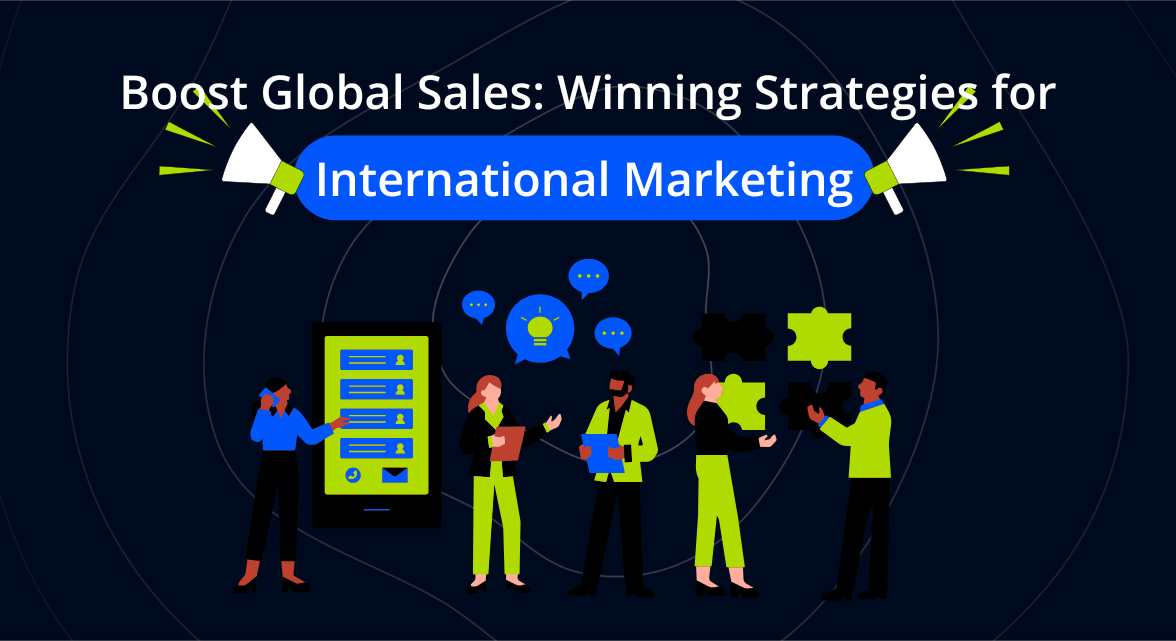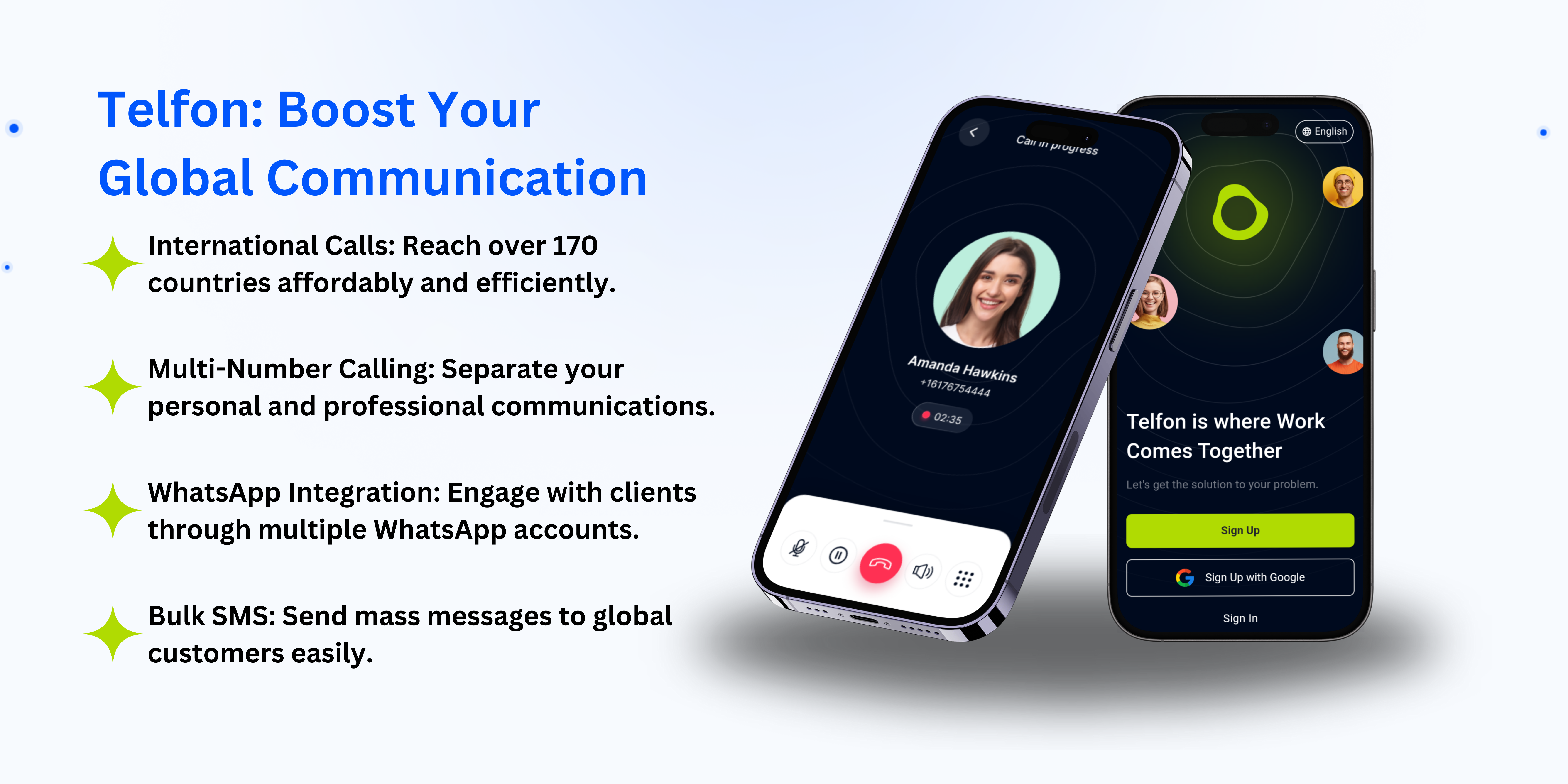
The global business landscape is changing rapidly. Thanks to technology and increased globalization, reaching customers beyond your home country is no longer just for large corporations. It’s becoming essential for businesses of all sizes looking for growth. But how can your sales and marketing teams effectively enter international markets, expand their reach, and ensure these efforts lead to real success? This blog post explores proven strategies to maximize your international presence and discusses powerful tools, like Telfon, that simplify communication across borders. To understand the scale of this opportunity, consider that global digital advertising spending reached over $700 billion in 2023, according to Statista data, highlighting the immense potential of the international market.(know more about it)
Becoming a global business means tapping into new opportunities. For sales and marketing teams, expanding beyond local markets is crucial for long-term success. By developing a strong international outreach strategy, your business can achieve several key objectives. These include unlocking new revenue streams, building a broader and more diverse customer base, enhancing your brand’s visibility on a global scale, and ensuring your business remains competitive and sustainable in the future. Focusing solely on a domestic market can limit your growth potential significantly.
Why International Expansion Matters Now More Than Ever
Globalization has created a profoundly interconnected world. Businesses operating only within their home country are missing out on significant growth avenues and potential customers. The digital age has lowered many barriers to entry for international markets, making it more accessible than ever before. This means your competitors, both large and small, are likely already exploring or operating in international territories. Staying competitive often requires looking beyond your current geographical boundaries.
The Shifting Global Landscape
The way people buy and interact with brands is increasingly influenced by global trends, yet local nuances remain critical. Understanding this dual nature is key. Markets in Asia, Europe, Latin America, and other regions offer vast populations with unique needs and purchasing power. Ignoring these markets means leaving substantial revenue potential on the table. Furthermore, diversifying your customer base across different regions can help protect your business from economic downturns or market saturation in a single country.
Key Benefits of Reaching Global Customers
Expanding internationally offers multiple advantages that contribute to your business’s overall health and future.
- Access New Revenue Streams: Unlock sales from customers in previously untouched markets.
- Build a Broader Customer Base: Grow your audience significantly beyond local limitations.
- Enhance Brand Visibility and Recognition: Position your brand on a global stage, increasing its reputation and trust.
- Drive Long-Term Sustainability: Reduce reliance on a single market and build resilience against local economic shifts.
- Gain a Competitive Edge: Outpace competitors who remain focused solely on domestic operations.
Essential Strategies for Boosting Global Sales
Successfully entering and thriving in international markets requires careful planning and targeted execution. It’s not simply about translating your current strategy; it’s about adapting it to resonate with new audiences.
Deep Dive into Market Research and Localization
Before making any significant moves, you must thoroughly understand the specific markets you plan to enter. Cultural, economic, political, and social factors all play a crucial role in how your product or service will be received. What works in one country might completely fail in another. Localization goes beyond language translation; it means adapting your entire offering, messaging, and marketing approach to fit the local context.
Conducting Effective Local Research
Gathering detailed information about your target markets is fundamental. This research should be comprehensive and ongoing.
- Analyze Local Consumer Behavior: Study how people in the target region shop, their preferred payment methods, their media consumption habits, and their decision-making processes.
- Research Local Competitors: Identify businesses already operating successfully in the market. Understand their strategies, pricing, strengths, and weaknesses.
- Monitor Social and Cultural Trends: Stay informed about cultural norms, holidays, social media trends, and any sensitivities that might impact your brand messaging.
- Assess the Economic Climate: Look at average income levels, economic stability, currency fluctuations, and overall market size and growth potential.
- Understand Regulatory and Legal Requirements: Investigate local laws regarding business operations, marketing, data privacy (like GDPR in Europe), and product standards.
Identifying Your Best Target Markets
Not every international market is a good fit for every business. Focus your resources on regions where your offering can truly meet a specific need or solve a problem better than existing solutions.
Assess the alignment between your product or service and local needs or gaps.Evaluate the competitive landscape and potential barriers to entry.
Prioritize markets based on research findings.
Consider market size, economic health, and growth projections.
Evaluate the competitive landscape and potential barriers to entry.
Leveraging Digital Channels for Global Impact
Digital marketing is a powerful engine for reaching international audiences cost-effectively. However, a global digital strategy requires specific adjustments compared to a purely domestic one.
Global SEO: Getting Found Worldwide
Making your business visible in international search results is critical. This involves adapting your website and content for local search engines and languages. International SEO is more than just translating keywords; it’s about understanding how people in different regions search for information.
- Implement Hreflang tags to signal the language and regional targeting of your pages to search engines.
- Create region-specific sitemaps and submit them to local search consoles (e.g., Google Search Console, Baidu Webmaster Tools).
- Optimize for local search engines popular in specific regions, such as Baidu in China or Yandex in Russia.
- Conduct thorough keyword research for each target market, considering local phrasing and search intent.
- Build localized landing pages or even country-specific subdomains or websites.
Strategic International Paid Advertising
Running Pay-Per-Click (PPC) campaigns allows you to drive targeted traffic from specific international locations. Platforms like Google Ads, social media ads, and local ad networks offer powerful geo-targeting capabilities.
- Tailor ad copy, visuals, and landing pages to the language, culture, and specific offers relevant to each target region.
- Adjust your budget and bidding strategy based on the competition and potential ROI in each market.
- Use precise geo-targeting settings to ensure your ads are shown only to your desired audience locations.
- Consider local payment methods and currencies in your ad campaigns and landing pages.
Connecting Through Global Social Media
Social media is essential for building brand awareness and engaging with potential customers worldwide. However, the dominant platforms vary significantly by country.
- Research which social media platforms are most popular and influential in your target markets (e.g., WeChat in China, VK in Russia, Facebook and Instagram globally, Line in parts of Asia).
- Create content that is culturally relevant and resonates with the local audience.
- Engage with users in their native language.
- Consider running targeted social media ad campaigns specific to each region’s demographics and interests.
Building Trust with Multilingual Support
Offering customer support in your international customers’ native languages is crucial for building trust and ensuring satisfaction. Customers feel more valued and understood when they can communicate comfortably.
Offering Support in Local Languages
Providing support in multiple languages can significantly improve customer experience and loyalty.
- Hire customer service agents who are native speakers or highly proficient in the target languages.
- Implement live chat or email support with built-in translation tools for immediate communication.
- Develop a comprehensive knowledge base or FAQ section translated into the languages of your key markets.
- Train your support team on cultural nuances and communication styles relevant to each region.
Ensuring Around-the-Clock Availability
Given the different time zones across the globe, offering 24/7 customer service provides a major competitive advantage.
- Implement a follow-the-sun model with support teams in different regions.
- Utilize AI-powered chatbots to handle common queries instantly, regardless of time.
- Provide clear expectations about support hours for each region if 24/7 is not feasible.
Forging Strong International Connections
Building relationships within your target markets can accelerate your expansion and increase your credibility. Local partners and industry events offer valuable opportunities.
Partnering with Local Experts
Forming strategic partnerships with local businesses or individuals can significantly smooth your market entry.
- Identify potential partners such as distributors, resellers, marketing agencies, or complementary service providers.
- Look for partners with a strong local presence, established network, and deep understanding of the market.
- Collaborate on co-marketing initiatives, joint ventures, or distribution agreements that benefit both parties.
- Leverage their local expertise to navigate cultural differences, regulatory hurdles, and market specifics.
Participating in Global Industry Events
Attending or participating in international trade shows, exhibitions, and conferences is an effective way to connect directly with potential customers, partners, and industry leaders.
- Showcase your products or services to a targeted audience.
- Network with potential partners and build valuable connections.
- Gain insights into market trends, competitor activities, and industry best practices.
- Increase brand awareness and establish your presence in the market.
rate seamlessly across borders without worrying about local phone lines. It simplifies communication, enhances customer interaction, and boosts your international outreach efforts.

Streamlining Global Communication with Technology
Effective global communication is vital for international business, but time zones, language barriers, and high costs of traditional phone systems present major hurdles for sales, marketing, and support teams. Telfon, a cloud-based virtual phone system, overcomes these challenges by offering a flexible, cost-effective solution for managing global calls, messages, and customer interactions without physical infrastructure.
This is where a modern cloud-based communication solution becomes invaluable. Telfon acts as a virtual phone system designed to simplify and enhance communication for businesses expanding internationally. It provides a flexible and cost-effective way to manage global calls, messages, and customer interactions without the need for physical infrastructure in each country. Whether you are a small team or a large corporation, Telfon offers a suite of features specifically beneficial for international sales, marketing, and support teams:
| Feature | Description |
|---|---|
| International Calls | Make affordable calls to over 180+ countries directly from the app or web, keeping communication costs manageable. |
| Purchase Virtual Numbers | Obtain virtual phone numbers from various countries, allowing your business to have a local presence number in target markets. |
| Multi-Number Calling | Manage separate virtual numbers for different regions or purposes (like sales vs. support) from a single account. |
| WhatsApp Integration | Engage with clients via WhatsApp using multiple accounts, perfect for sales and customer support teams who rely on this popular messaging platform in many regions. |
| Bulk SMS | Send mass text messages to potential customers globally for marketing campaigns or important notifications. |
| Call Forwarding & Voicemail | Ensure no call is missed by forwarding calls or utilizing customizable voicemail, including voicemail-to-text transcriptions. |
| Call Recordings | Record calls for training, quality control, and compliance purposes. |
| User Analytics (Business Plans) | Track call and SMS history, analyze user activity, and gain insights into communication patterns across your team. |
| Number Management (Business Plans) | Easily manage and assign virtual numbers to team members based on their target markets. |
For businesses like international hiring institutes, customer support centers, or sales organizations working with global clients, Telfon simplifies daily communication workflows. It enables teams to act locally while operating globally.
Optimizing and Measuring Your Global Efforts
Expanding internationally is an ongoing process. You need to continuously optimize your strategies and measure their effectiveness to ensure you are investing your resources wisely and achieving your goals.
Mobile-First for a Global Audience
Mobile device usage varies across the globe, but it is universally significant. In many emerging markets, mobile is the primary or only way people access the internet. Therefore, optimizing your online presence for mobile devices is non-negotiable for global success.
- Ensure your website uses responsive design so it adapts seamlessly to any screen size.
- Prioritize website loading speed, especially on mobile, as connectivity can be slower in some regions.
- Create mobile-friendly landing pages specifically designed for users clicking on mobile ads.
- Optimize email templates for mobile viewing, as many international customers check emails on smartphones.
Tracking Success and Refining Strategy
Data analysis is critical to understanding what’s working in each market and making informed decisions. Regularly tracking key metrics allows you to identify successful strategies and areas that need improvement.
Essential Metrics to Monitor
Focus on metrics that provide insights into performance within each specific international market.
| Metric | Purpose/Description |
|---|---|
| Website Traffic by Country/Region | Understand where your visitors are coming from. |
| Conversion Rates (by Region) | Measure how effectively your campaigns are turning visitors into customers in different markets. |
| Customer Acquisition Cost (CAC) by Region | Evaluate the efficiency of your marketing spend in each territory. |
| Sales Revenue by Region | Track financial performance per market. |
| Customer Engagement Metrics (per Platform/Region) | Analyze social media interaction, email open rates, etc. |
| Support Ticket Volume and Resolution Time (by Language/Region) | Assess the effectiveness of your customer support globally. |
Use data from analytics platforms to make data-driven decisions. This might involve shifting budget to more profitable markets, refining messaging, or adjusting your product offering based on local feedback.
Frequently Asked Questions
Q1: How do I choose which international market to target first?
A: Start with thorough market research. Look for markets where there is a clear need for your product or service, a favorable economic climate, manageable competition, and cultural alignment with your brand. Prioritize based on potential ROI and feasibility.
Q2: Is localization really necessary, or can I just translate my content?
A: Localization is highly recommended. It goes beyond simple translation to adapt your content, messaging, visuals, and even product features to resonate with the cultural norms, values, and preferences of the local audience. This builds trust and improves effectiveness.
Q3: Can small businesses afford to expand internationally?
A: Yes, technological advancements and digital marketing tools have significantly lowered the barrier to entry for small businesses. Starting with targeted digital campaigns or exploring partnerships in specific markets can be cost-effective entry points.
Q4: What are the biggest challenges when expanding globally?
A: Common challenges include cultural differences, language barriers, navigating complex regulations and legal frameworks, managing logistics and payment processing across borders, and intense competition in established markets. Careful planning and local expertise help overcome these.
Conclusion
Taking your business global offers immense potential for growth and sustainability. It requires a strategic approach that involves understanding new markets, leveraging digital tools effectively, providing localized support, building strong partnerships, and utilizing technology to connect seamlessly. Optimizing your internal and external communication channels is a foundational element for any successful global venture.









